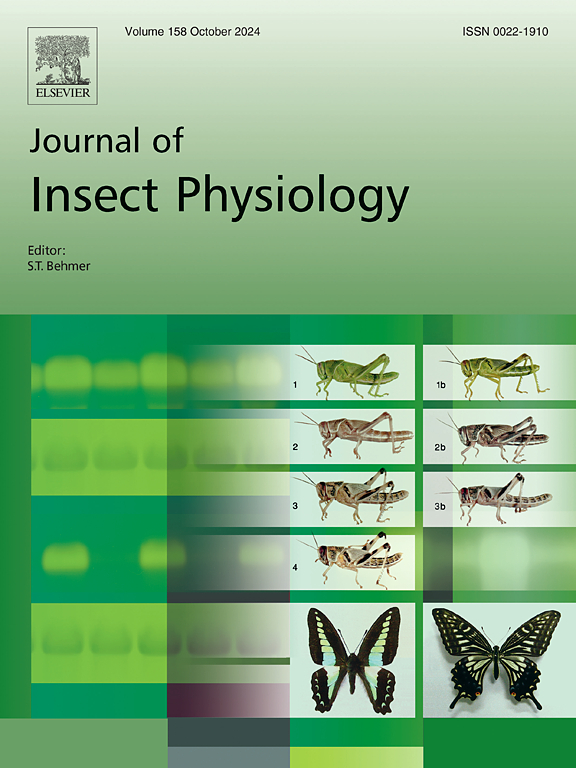模拟生物年龄以评估成熟和衰老(蜜蜂)
IF 2.3
2区 农林科学
Q1 ENTOMOLOGY
引用次数: 0
摘要
气候变化引起的环境压力,尤其是温度和湿度的波动,影响着蜜蜂(Apis mellifera)这种具有复杂社会结构的模式生物的行为和生理。工蜂是蜂群中数量最多的成员,它们执行的任务是基于年龄的,它们的寿命从短命的夏季蜜蜂到长寿的冬季蜜蜂不等。虽然调节衰老过程和了解压力如何影响成熟对群体生存至关重要,但这些机制仍然知之甚少。为了解决这个问题,我们分析了在受控环境条件和低DWV水平下,11个年龄组(0、3、6、8、10、12、14、16、18、21和25天)的标记工蜂在开花期间的两个生理性状(下咽腺发育和脂肪体脂质质量)和6个基因(ilp1、ilp2、TOR1、JHAMT、AmGr10和Vg)的表达。五个基因(ilp1, ilp2, TOR1, JHAMT和AmGr10)被确定为可靠的年龄相关标记,并用于建立生物学年龄的预测模型。对开花、枯死和越冬早期14日龄工蜂的验证表明,季节压力影响生物老化,预测年龄为12.14天(开花)、14.64天(枯死)和28.17天(越冬早期)。越冬蜜蜂的加速生物老化,与疾病的存在和蜂群衰竭有关,证实了该模型的可靠性。该研究为社会昆虫的应激老化提供了新的见解,并为监测群体健康和恢复力提供了实用的工具。本文章由计算机程序翻译,如有差异,请以英文原文为准。

Modeling biological age to assess maturation and ageing (Apis mellifera)
Environmental stresses caused by climate change—especially fluctuations in temperature and humidity—affect the behavior and physiology of honeybees (Apis mellifera), a model organism with a complex social structure. Worker bees, the most numerous members of colonies, perform tasks based on age polyethism, with lifespans ranging from short-lived summer bees to long-lived winter bees. While regulating this aging process and understanding how stress influences maturation are crucial for colony survival, these mechanisms remain poorly understood. To address this issue, we analyzed two physiological traits (hypopharyngeal gland development and fat body lipid mass) and the expression of six genes (ilp1, ilp2, TOR1, JHAMT, AmGr10, and Vg) in marked workers across 11 age groups (0, 3, 6, 8, 10, 12, 14, 16, 18, 21, and 25 days) during the flowering period, under controlled environmental conditions and low DWV levels. Five genes (ilp1, ilp2, TOR1, JHAMT, and AmGr10) were identified as reliable age-related markers and were used to develop a predictive model of biological age. Validation on 14-day-old workers sampled during the Flowering, Dearth, and early Overwintering Periods demonstrated that seasonal stress affects biological aging, with predicted ages of 12.14 days (flowering), 14.64 days (dearth), and 28.17 days (early overwintering). The accelerated biological aging in overwintering bees, linked with disease presence and colony failure, confirmed the model’s reliability. This study provides new insights into stress-induced aging in social insects and presents practical tools for monitoring colony health and resilience.
求助全文
通过发布文献求助,成功后即可免费获取论文全文。
去求助
来源期刊

Journal of insect physiology
生物-昆虫学
CiteScore
4.50
自引率
4.50%
发文量
77
审稿时长
57 days
期刊介绍:
All aspects of insect physiology are published in this journal which will also accept papers on the physiology of other arthropods, if the referees consider the work to be of general interest. The coverage includes endocrinology (in relation to moulting, reproduction and metabolism), pheromones, neurobiology (cellular, integrative and developmental), physiological pharmacology, nutrition (food selection, digestion and absorption), homeostasis, excretion, reproduction and behaviour. Papers covering functional genomics and molecular approaches to physiological problems will also be included. Communications on structure and applied entomology can be published if the subject matter has an explicit bearing on the physiology of arthropods. Review articles and novel method papers are also welcomed.
 求助内容:
求助内容: 应助结果提醒方式:
应助结果提醒方式:


